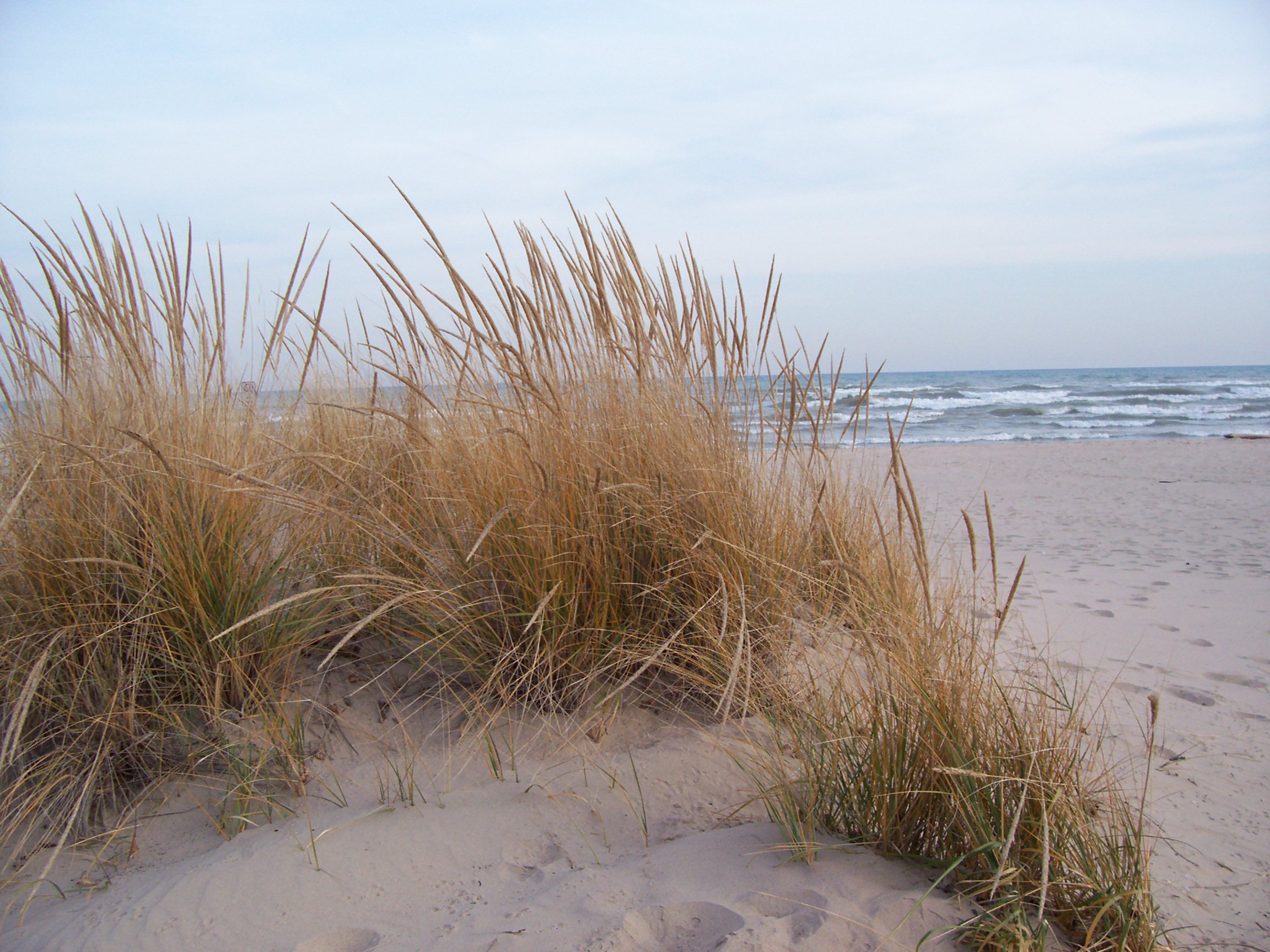- Ammophila breviligulata
Taxobox
name = American Beachgrass

image_width = 300px
image_caption = American beachgrass in November; note the characteristic seed heads rising above the leaf spikes.Kohler-Andrae State Park onLake Michigan .
regnum =Plant ae
divisio = Magnoliophyta
classis =Liliopsida
ordo =Poales
familia =Poaceae
genus = "Ammophila"
species = "A. breviligulata"
binomial = "Ammophila breviligulata"
binomial_authority = Fern."Ammophila breviligulata" (American beachgrass or American marram grass) is a species of
grass that is native to easternNorth America , where it grows on sand dunes along theAtlantic Ocean andGreat Lakes coasts. Beachgrass thrives under conditions of shifting sand, sand burial, and high winds; it is a dune-building grass that builds the first line ofsand dunes along the coast. Beachgrass is less vigorous in stabilized sand, and is only infrequently found further inland than the coastal foredunes. "A. breviligulata" was introduced to the Pacific coast of North America in the 1930s. It is proving to be invasive, and is increasingly important to coastal ecology and development in Oregon, Washington, and British Columbia.Botanical description
The leaves of "A. breviligulata" have deeply furrowed upper surfaces and smooth undersides, and grow convert|2|to|3|ft|m|sigfig=1 tall. The plant's
inflorescence is a spike-likepanicle that can reach convert|10|in|cm long; the seed head appears in late July or August. [cite web|title=PLANTS Profile for Ammophila breviligulata (American beachgrass) |publisher=U. S. Department of Agriculture |location=National Plant Data Center, Baton Rouge, LA 70874-4490 USA |url=http://plants.usda.gov/java/profile?symbol=AMBR |accessdate=2008-09-18] The species name "breviligulata" derives from the Latin "brevis" ("short") and "ligula" ("tongue"), [cite web|title=Ammophila breviligulata: Robert W. Freckmann Herbarium |url=http://wisplants.uwsp.edu/scripts/detail.asp?SpCode=AMMBRE |publisher=University of Wisconsin |accessdate=2008-09-20] which refers to a small feature of grasses called theligule ."A. breviligulata" is quite similar in appearance and ecology to a second species of beachgrass, "
Ammophila arenaria " (European beachgrass). As Nick Page has summarized, "Ammophila breviligulata" is distinguished from "A. arenaria" by smaller ligules (1-3 mm versus 10-30 mm long in "A. arenaria"), wider and less inrolled leaves, longer flower spike (25-35 cm versus 15-25 cm long in "A. arenaria"), and scaly rather than puberulent leaf veins on the upper leaf surface."cite web|title=Ammophila breviligulata (Poaceae) new to British Columbia |last=Page |first=Nick |editor=Ceska, A. |date=2001-11-15 |url=http://www.ou.edu/cas/botany-micro/ben/ben276.html |work=Botanical Electronic News - BEN #276 |accessdate=2008-09-19]Ecology
Both species of beachgrass are noted for their association with stable sand dunes, and observations in regions where they were introduced to coasts indicate that they actually build the first line of dunes on coasts (the foredunes). The plants spread rapidly (convert|6|to|10|ft|m annually) through the sand by subsurface runners (
rhizome s), and can produce up to 100 stems per clump annually.cite web|title=Plant Fact Sheet: American Beachgrass |publisher=United States Department of Agriculture |url=http://plants.usda.gov/factsheet/pdf/fs_ambr.pdf |date=2006-05-30 |accessdate=2008-10-07] They can tolerate burial in as much as 3 feet (1 meter) of sand; sand burial stimulates the rhizomes to grow vertically, and is actually essential to plant vigor.cite web|title=Invasive Plants of California's Wildland: Ammophila arenaria |last=Apteker |first=Rachel |publisher=California Invasive Plants Council |url=http://www.cal-ipc.org/ip/management/ipcw/pages/detailreport.cfm@usernumber=5&surveynumber=182.php |accessdate=2008-09-18] The beachgrass species are also very good examples ofxerophyte s, being able to thrive on arid to semi-arid beachdune s. The plant has several mechanisms for adapting to heat stress or wind. The long narrow leaves can roll or fold, and the rough upper leaf surface, which contains the gas exchange openings (stomata), can orient itself away from wind.Beachgrass is a dominant species on foredunes, and indeed is sometimes the only plant found there. It is much less vigorous further in from the coastline, which is puzzling. Why should a species that competes so well on foredunes be fairly unsuccessful just a few meters further in from the coast, where other plants usually dominate? One mechanism for this effect that has been extensively studied by Wim van der Putten and his colleagues is based on the susceptibility of "Ammophila" species to soil pathogens such as
nematode s. [cite journal|last=van der Putten |first=Wim H. |coauthors=Peters, Bas A. M. |title=How Soil-Borne Pathogens May Affect Plant Competition |work=Ecology |volume=78 |issue=6 |year=1997 |month=September |pages=1785-1795 |url=http://www.jstor.org/stable/2266101?origin=JSTOR-pdf] [cite journal|last=van der Putten |first=Wim H. |title=Plant Defense Belowground and Spatiotemporal Processes in Natural Vegetation |work=Ecology |volume=84 |issue=9 |year=2003 |month=September |pages=2269-2280 |url=http://www.jstor.org/stable/3450133?origin=JSTOR-pdf ] The density of these pathogens is low in freshly deposited sand, but builds up in the roots of beachgrass on stabilized sand. While the details are complex, the result is that beachgrass is largely limited to the foredunes that it builds, which are immediately adjacent to water's edge and where sand is removed and redeposited fairly frequently.Invasiveness on the Pacific coast of North America
Starting in the 19th Century, "A. arenaria" was introduced to the Pacific coast of North America to help control beach sands; it served this role so well that it is now considered invasive from
California north toBritish Columbia .cite web|title=Washington's Coast: Plants - Beachgrass |url=http://www.ecy.wa.gov/programs/sea/coast/plants/dunegrass.html |publisher=Washington State Department of Ecology |accessdate=2008-09-19] [cite journal|last=Dukes |first=Jeffrey S. |coauthors=Mooney, Harold A. |title=Disruption of ecosystem processes in western North America by invasive species |work=Revista Chilena de Historia Natural |volume=77 |pages=411-437 |year=2004 |url=http://globalecology.stanford.edu/DGE/Dukes/Dukes&Mooney2004.pdf] "A. arenaria" built foredunes (the dunes closest to the beach) that are typically about convert|14|ft|m high, which is much higher than the dunes associated with the native dune grass species "Leymus mollis ".
Wikimedia Foundation. 2010.
